Vatican Art Story | Location | Opening Hours Tickets | Authorisations
Art Story Sistine Chapel | Raphael | Caravaggio | Sculptures | Van Gogh |
Caravaggio “The Entombment of Christ” or “The Deposition of Christ” - Vatican Museum in Rome
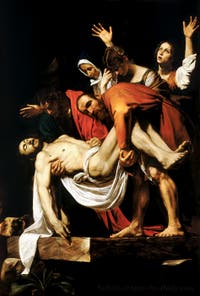
Entombment of Christ
Caravaggio “The Entombment of Christ or The Deposition of Christ”
Painting - Oil on Canvas (300 x 203 cm) 1602-1603The Composition of the “Entombment of Christ” by Caravaggio
“The Deposition of Christ in the Sepulchre” or “Entombment” by Caravaggio is one of the artist’s most powerful paintings, the one that was also the most admired during his lifetime.Its composition is compelling and ingenious.
Caravaggio built a diagonal formed by the “stacking” of the characters represented, from Christ to the raised hands of the desperate woman.
This diagonal can be read in both directions, ascending and descending.
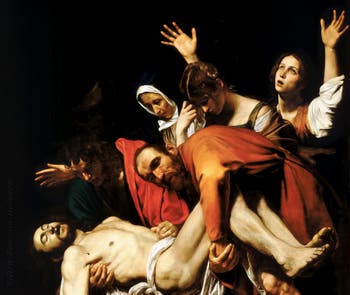
Entombment of Christ First, the diagonal can be read towards the tomb where this waxy-skinned corpse, whose hand hangs, deprived of life, will be laid.
But this diagonal draw us at the same time to the top of the picture, to these raised hands and this face praying to Heaven, an ascending diagonal foreshadowing the Spirit who will ascend to the Father.
Up, Down, Indoor, Outdoor
Caravaggio does not stop with this double ascending and descending reading of his composition.He also brings us into his painting; he makes it lively and present by showing us the amazement, the sadness, and the pain of the faces, by extending these hands that transmit despair, the mouth of this woman whose cry pierces us with its quiet intensity.
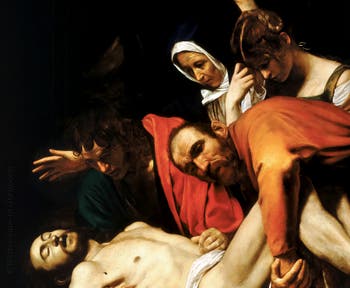
Entombment of Christ We are in front of them, we participate in this tragic scene, we live it, and suddenly, we are led out of it when we see the face turned towards us of the character who surrounds Christ’s legs with his arms: he is the only one who is staring at us, who speaks directly to us.
It is not by chance that Caravaggio placed this face at the centre of the scene and at its diagonal; it is also the central axis of the work.
The Symbol of the Stone Slab of the Tomb of Christ
In the same way, the movements of the figures are frozen, as if fixed by the perfectly horizontal stone slab at the bottom of the painting.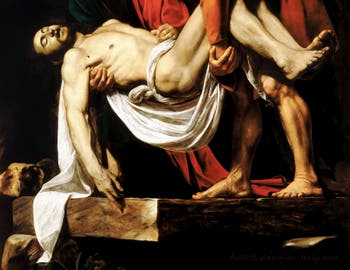
Entombment of Christ This stone, painted like a beam, reminds us of the cross on which Jesus was nailed, and crucified.
The body of Jesus and the stone slab of his tomb are presented in a perfectly parallel way.
This double horizontal line formed by Jesus and the slab shows us the immobility of death while the other characters are represented in movement because of their pain.
This stone slab is presented by Caravaggio as the altar where sacrifice is made and manifested, where “the Lamb of God takes away the sins of the world.”
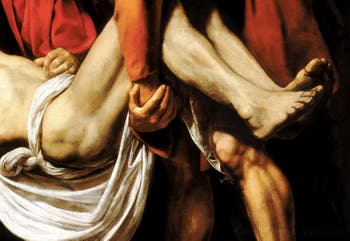
Entombment of Christ The slab thus becomes a robust base of the scene; you can lean on it, almost reassure yourself at the sight of it, just as the powerful feet and legs of the one who carries the body of Christ are anchored on this stone.
A symbolic stone slab: Jesus is the cornerstone, the living stone on which the New Jerusalem will be built, the foundation of the Church.
The image of these three women and these two men whose feet are placed on this stone slab is highly symbolic: They are already the Church.
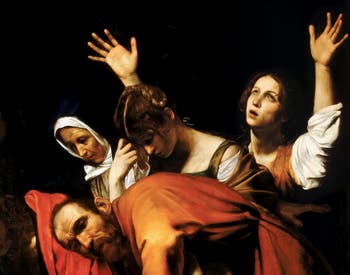
Entombment of Christ
“The Entombment” of Caravaggio: a Freeze Frame
The whole scene is a freeze frame of this crucial moment, the movements of the hands in the air, the expressions.
We are watching, we see the scene; it is there, in front of us, very actual, with this man watching us.
In his “deposition of Christ and his burial”, Caravaggio perfectly knew how to transmit pain and hope to us.
The Three Marys of the Entombment
The oldest is the virgin Mary, mother of Jesus, she wears a veil, and her face is frozen.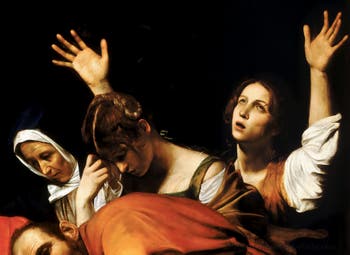
Entombment of Christ At his side, a young woman, Saint Mary Magdalene, wipes away her tears with her handkerchief.
Mary Magdalene will be the first to witness the Resurrection, the first whose hope will become certain. While the third, older, screams in pain while opening her arms in despair, but also in helplessness, why has Heaven allowed this to happen?
But his outstretched arms can also be seen as an imploration, a prayer awaiting the Resurrection.
She is the third Mary, Mary of Cleophas, who accompanied Jesus to Golgotha and remained with him until the last moment.
The Two Men at the Entombment of Caravaggio
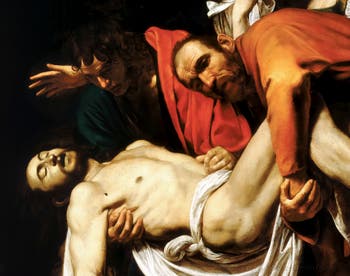
Entombment of Christ The first man, who bears Christ, looking at the wax face of Jesus, is John the Evangelist, dressed in his green tunic covered by a long red coat.
He is between Jesus and Mary, whose hand, as a result, can no longer touch the head of her Son, as if John had become her new Son.
This is what Caravaggio reproduced here, the echo of Christ’s words to his mother while he was on the cross:
“Woman here is your Son! and to Jean: Here is your mother!”
Gospel of Saint John 19, 26-27
The second man, the one looking at us, would be Nicodemus, the one to whom Jesus said:
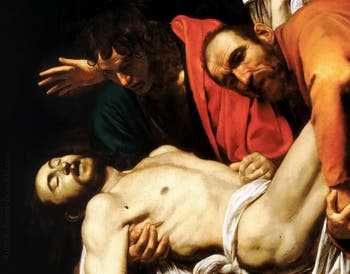
Entombment of Christ
“God did not send the Son into the world to judge the world, but for the world to be saved through him.
Whoever believes in him is not judged; whoever does not believe is already judged because he did not want to believe in the name of the only Son of God.
This is the judgment: Light came into the world, and men preferred darkness to light; for their works were evil. [...]
But those who practice the Truth come to light to show that their works are carried out in God.”
Gospel of Saint John 3, 17-21
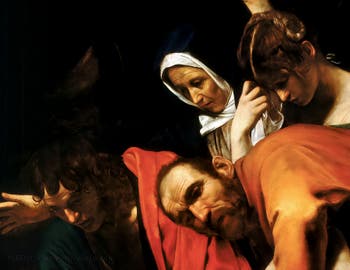
Entombment of Christ And Nicodemus is there, his wrinkled, tired, perplexed face, whose intense look stares at us, reminds us of these words, challenges us with our eyes, questions us, brings us face to face with ourselves, before the body of Christ without life, calls us to the light.
Michelangelo in Caravaggio's “Entombment”
But Caravaggio’s Nicodemus also strangely reminds us of Michelangelo’s face; the similarity is striking to the portrait of Michelangelo made by Giacomo da Volterra, his disciple.
Michelangelo sculpted the sublime “Pietà” in Saint Peter’s Basilica, Michelangelo who represented himself in his deposition of the “Pietà Bandini” at Sforza Castle in Milan.

Entombment of Christ But Michelangelo’s representation of Nicodemus goes far beyond Caravaggio’s admiration for this brilliant artist.
Nicodemus is also considered the prototype of the Christian artist, the first one to fashion an image of Christ with his hands.
Thus Nicodemus represents all artists who have put themselves at the service of Faith and Truth, and for Caravaggio, Michelangelo is the greatest of them.
The artist that he represents is full of humility, barefoot, wearing a simple work tunic.
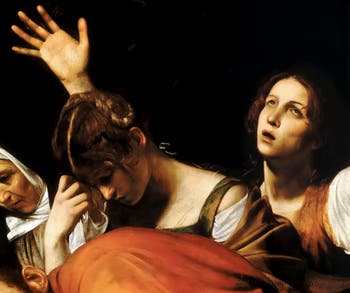
Entombment of Christ
The Arm and the Hand of Christ
We are facing the arm of Christ, his dead hand, which bears the mark of the crucifixion and whose position of his fingers still seems to bless us.Caravaggio also highlights his three fingers to remind us of the three days that must elapse before the Resurrection.
The Resurrection Plant in the “Entombment”
The Resurrection is suggested by the plant that we see under the stone, which grows in the shade and whose leaves already touch the shroud that covers the body of Christ.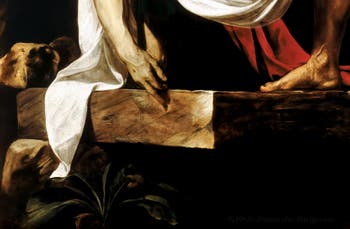
Entombment of Christ A plant that would be a Saint-Fiacre herb in the growth phase preceding its flowering.
A plant that can be found in other Caravaggio paintings, such as “The Rest on the Flight into Egypt” at the Doria Pamphilj Gallery or “Saint John the Baptist” at the Capitoline Museums in Rome.
A plant whose green colour is already a harbinger of rebirth, of the Resurrection of Christ.
Bibliography: The superb book (in Italian only) by Luca Frigerio “Caravaggio, La Luce e le Tenebre”, published by Editions Ancora.
Art Story Sistine Chapel | Raphael | Caravaggio | Sculptures | Van Gogh |
Vatican Art Story | Location | Opening Hours Tickets | Authorisations
Back to Top of Page

